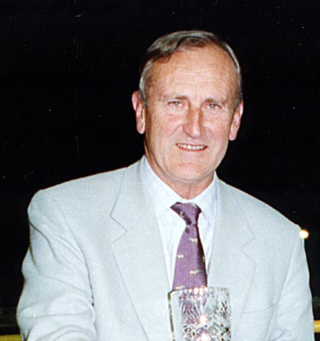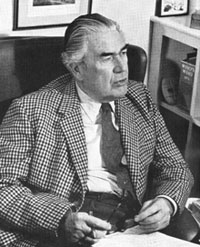Related Research Articles

Edward Ralph Dexter, was an England international cricketer.

Sir Leonard Hutton was an English cricketer. He played as an opening batsman for Yorkshire County Cricket Club from 1934 to 1955 and for England in 79 Test matches between 1937 and 1955. Wisden Cricketers' Almanack described him as "one of the greatest batsmen in the history of cricket". He set a record in 1938 for the highest individual innings in a Test match in only his sixth Test appearance, scoring 364 runs against Australia, a milestone that stood for nearly 20 years. Following the Second World War, he was the mainstay of England's batting. In 1952, he became the first professional cricketer of the 20th century to captain England in Tests; under his captaincy England won the Ashes the following year for the first time in 19 years.

Douglas Robert Jardine was a British cricketer who played 22 Test matches for England, captaining the side in 15 of those matches between 1931 and 1934. A right-handed batsman, he is best known for captaining the English team during the 1932–33 Ashes tour of Australia. During that series, England employed "Bodyline" tactics against the Australian batsmen, headed by Donald Bradman, wherein bowlers pitched the ball short on the line of leg stump to rise towards the bodies of the batsmen in a manner that most contemporary players and critics viewed as intimidatory and physically dangerous. As captain, Jardine was the person responsible for the implementation of Bodyline.

John Michael Brearley is a retired English first-class cricketer who captained Cambridge University, Middlesex, and England.

Ernest William Hornung was an English author and poet known for writing the A. J. Raffles series of stories about a gentleman thief in late 19th-century London. Hornung was educated at Uppingham School; as a result of poor health he left the school in December 1883 to travel to Sydney, where he stayed for two years. He drew on his Australian experiences as a background when he began writing, initially short stories and later novels.

Albert Edwin Trott was a Test cricketer for both Australia and England. He was named as one of the Wisden Cricketers of the Year in 1899. He is believed to be the only batsman to have struck a ball over the top of the Lord's Pavilion. He is also one of only two players to take two hat-tricks in the same first-class innings, the other being Joginder Rao. Despite his notability, having played in 375 first-class matches including 5 Tests, he was almost penniless when he committed suicide at the age of 41.
This is a bibliography of literary and historical works about cricket. The list is sorted by author's name. It is inevitably highly selective. The 1984 edition of E. W. Padwick's A Bibliography of Cricket had more than 10,000 entries.

Ernest William "Jim" Swanton was an English journalist and author, chiefly known for being a cricket writer and commentator under his initials, E. W. Swanton. He worked as a sports journalist for The Daily Telegraph and as a broadcaster for BBC Radio for 30 years. He was a regular commentator on Test Match Special, easily recognised by his distinctive "fruity" voice. After "retiring" in the 1970s, he continued to write occasional articles and columns until his death in 2000.
The Cricket Society is a charitable organisation founded in 1945 as the Society of Cricket Statisticians at Great Scotland Yard, London. It has grown steadily to be the largest body of its kind in the cricket world. The Cricket Society now has approaching 2000 members in the United Kingdom and the cricket playing countries of the world. Its current President is John Barclay.

Arthur Ford was an American psychic, spiritualist medium, clairaudient, and founder of the Spiritual Frontiers Fellowship (1955). He gained national attention when he claimed to have contacted the dead son of Bishop James Pike in 1967 on network TV. In 1928 Ford claimed to have contacted the deceased spirits of Houdini's mother and later in 1929 Harry Houdini himself.
William Mycroft was an English cricketer who played first-class cricket for Derbyshire and MCC between 1873 and 1886. He was a left-arm fast bowler with a great deal of spin and a dangerous yorker that was often believed to be unfair – which may explain why he was not considered for the earliest Test Matches despite being in his prime. He took 863 first-class wickets at an average of 12.09 with 87 five-wicket innings and 28 ten-wicket matches in his career. His first ten-wicket match in 1875 against Nottinghamshire became the first of six in only nine games that season. He holds the Derbyshire record for most wickets in a single match, with figures of 17–103 against Hampshire at the Antelope Ground, Southampton in July 1876. This is one of only two times a player has taken seventeen wickets in a match and finished on the losing side – the other, by Walter Mead in 1895 was also against Hampshire. Mycroft had no pretensions as a right-handed tail end batsman: he scored only 791 first-class runs at an average of 5.34 and prior to Alf Hall and Father Marriott remained the last significant cricketer who took more wickets than he scored runs.
Francis Joseph Shacklock was an English cricketer who played first-class cricket for Nottinghamshire in 1883 and between 1886 and 1893, for Derbyshire in 1884 and 1885, for MCC between 1889 and 1893, and for Otago in New Zealand from 1903 to 1905. Shacklock may have been the inspiration for the first name of Arthur Conan Doyle's character Sherlock Holmes.
John O'Connor was an English cricketer who played for Derbyshire in 1900.
The Sherlockian game is the pastime of attempting to resolve anomalies and clarify implied details about Sherlock Holmes and Dr. Watson from the 56 short stories and four novels that make up the Sherlock Holmes canon by Arthur Conan Doyle. It treats Holmes and Watson as real people and uses aspects of the canonical stories combined with the history of the era of the tales' settings to construct fanciful biographies of the pair.

Sir Arthur Ignatius Conan Doyle was a British writer and physician. He created the character Sherlock Holmes in 1887 for A Study in Scarlet, the first of four novels and fifty-six short stories about Holmes and Dr. Watson. The Sherlock Holmes stories are milestones in the field of crime fiction.
George Herbert Chesterton MBE was an English cricketer who played first-class cricket between 1949 and 1966. The bulk of his appearances were for Worcestershire, whom he represented between 1950 and 1957. He was capped by the county in 1950. Very much a specialist bowler, he never reached 50 in over 100 first-class innings.

Surgeon-Captain John Ernest Trask was an English Army doctor and amateur cricketer. He served in the Army Medical Services from 1887 until his death from cholera in Sudan during 1896. He was posthumously mentioned in dispatches, in which he was praised for his role in managing the cholera outbreak. He is thought to have been referred to in Sir Arthur Conan Doyle's 1918 work The New Revelation, as a spirit Doyle converses with.
John Sandford Robinson was an English cricketer. He played for Cambridge University, the Marylebone Cricket Club (MCC) and Nottinghamshire between 1888 and 1896. He was born at Arnold, Nottinghamshire and died at Worksop, also in Nottinghamshire. He was known during his lifetime as "Sandford Robinson" as his father was called "John Robinson".

Arthur J. Raffles is a fictional character created in 1898 by E. W. Hornung, brother-in-law of Sir Arthur Conan Doyle, the creator of Sherlock Holmes. Raffles is, in many ways, an inversion of Holmes – he is a "gentleman thief", living at the Albany, a prestigious address in London, playing cricket as a gentleman for the Gentlemen of England and supporting himself by carrying out ingenious burglaries. He is called the "Amateur Cracksman" and often, at first, differentiates between him and the "professors" – professional criminals from the lower classes.
"The Field Bazaar" is a short story by Arthur Conan Doyle, first published on November 20, 1896 in a special "Bazaar Number" of The Student, a publication of the students' representative council at Edinburgh University. It is a Sherlock Holmes story, published under Conan Doyle's byline and featuring both Holmes and his partner, Dr. John Watson. It is, however, treated by most experts as a parody or pastiche not suitable for inclusion in the traditional 60-story canon of Sherlock Holmes, though there are dissenters.
References
- 1 2 3 "Sandford, Christopher 1956–". Encyclopedia.com. Retrieved 10 January 2021.
- ↑ Christopher Sandford, "Never See His Kind Again", Chronicles Magazine , April 2013, pp. 38–41.
- ↑ "Christopher Sandford". Russian Life. Retrieved 10 January 2021.
- ↑ 'Cambridge University tripos results in philosophy and history', Times, 30 June 1977, p. 18. Retrieved 9 August 2021.
- ↑ "Christopher Sandford". Macmillan. Retrieved 10 January 2021.
- ↑ "Christopher Sandford". Duckworth. Retrieved 10 January 2021.
- ↑ "The Cricket Society/ MCC Book of the Year". The Cricket Society. Archived from the original on 15 April 2019. Retrieved 20 April 2021.